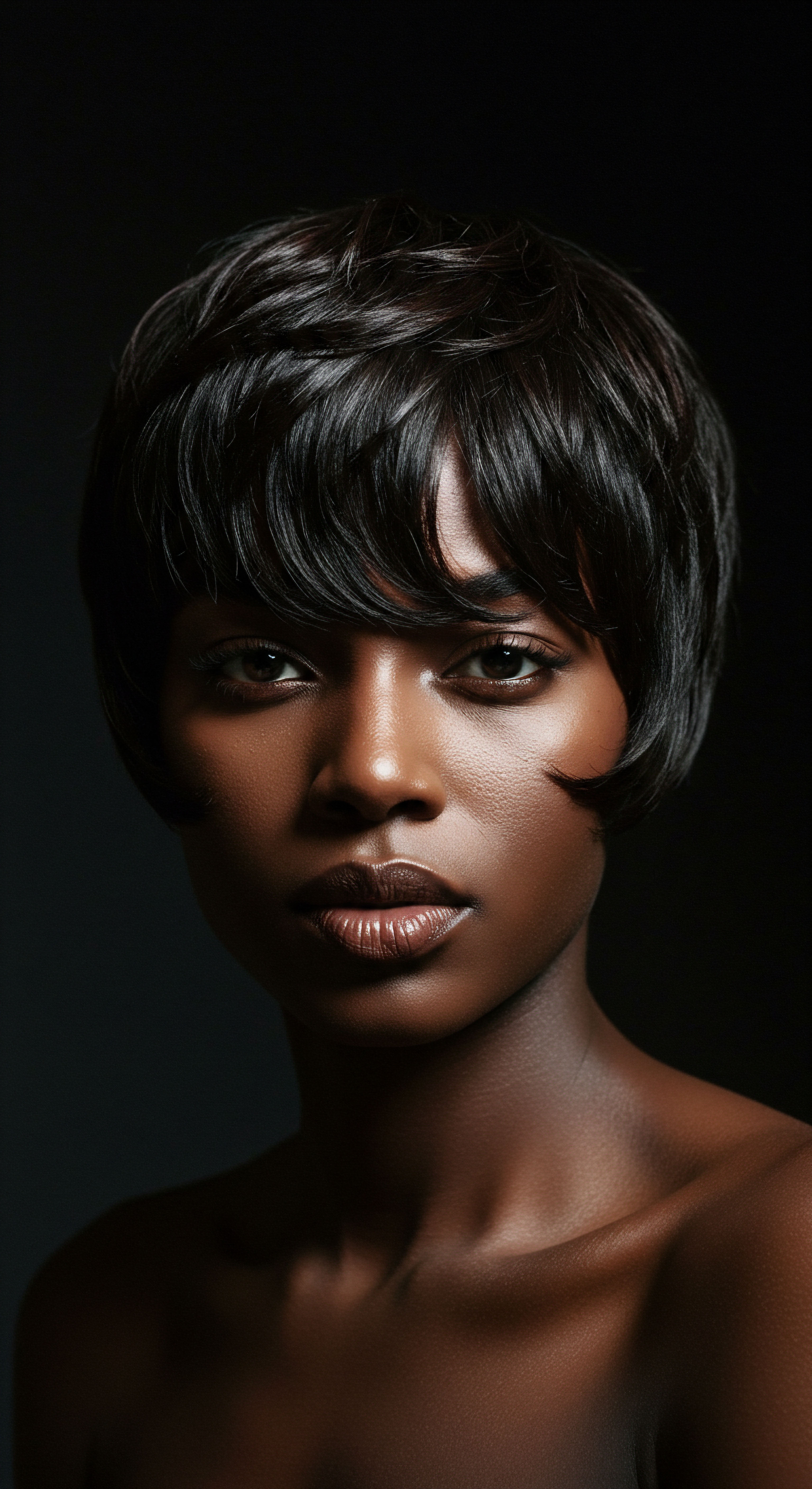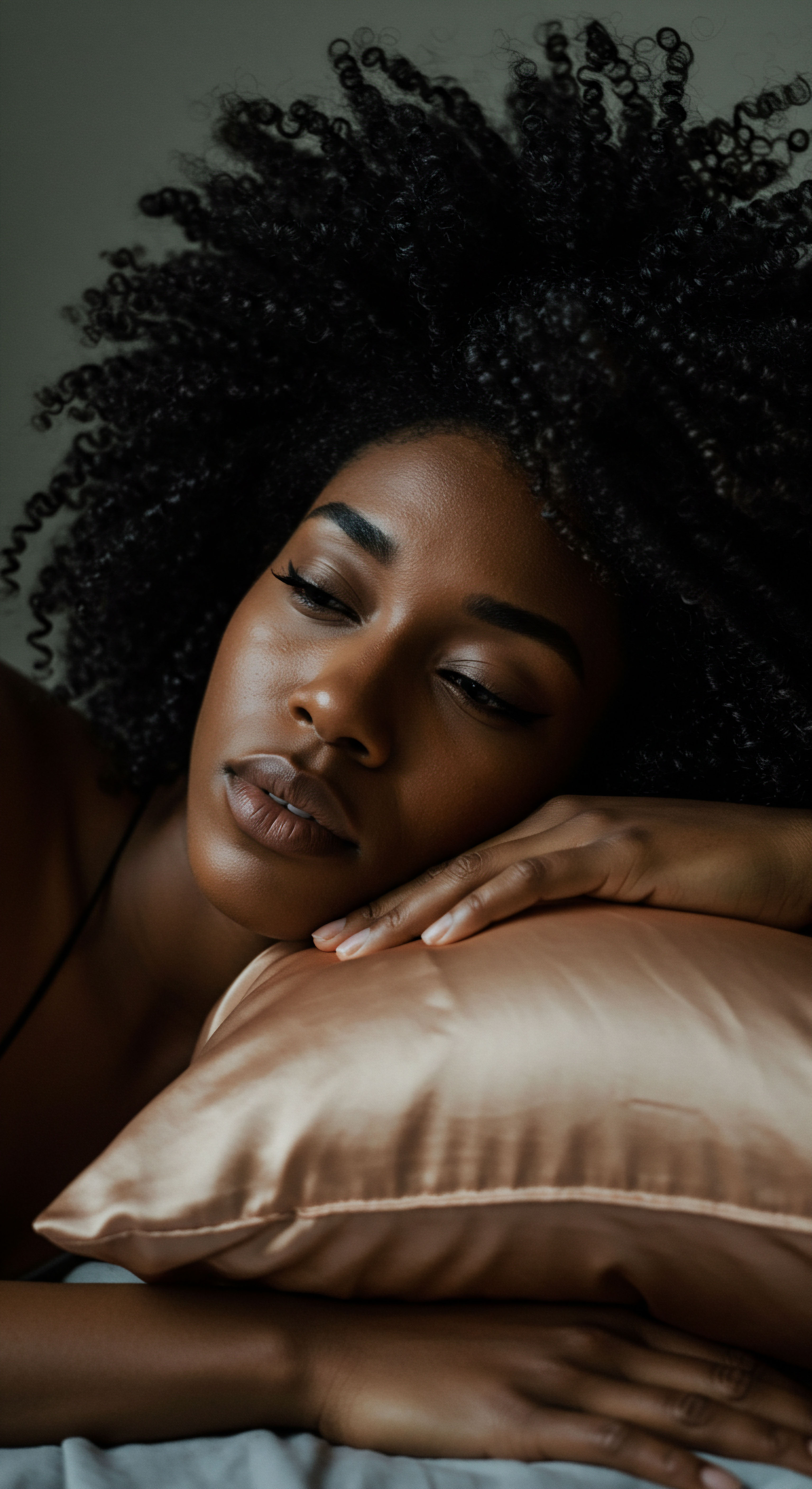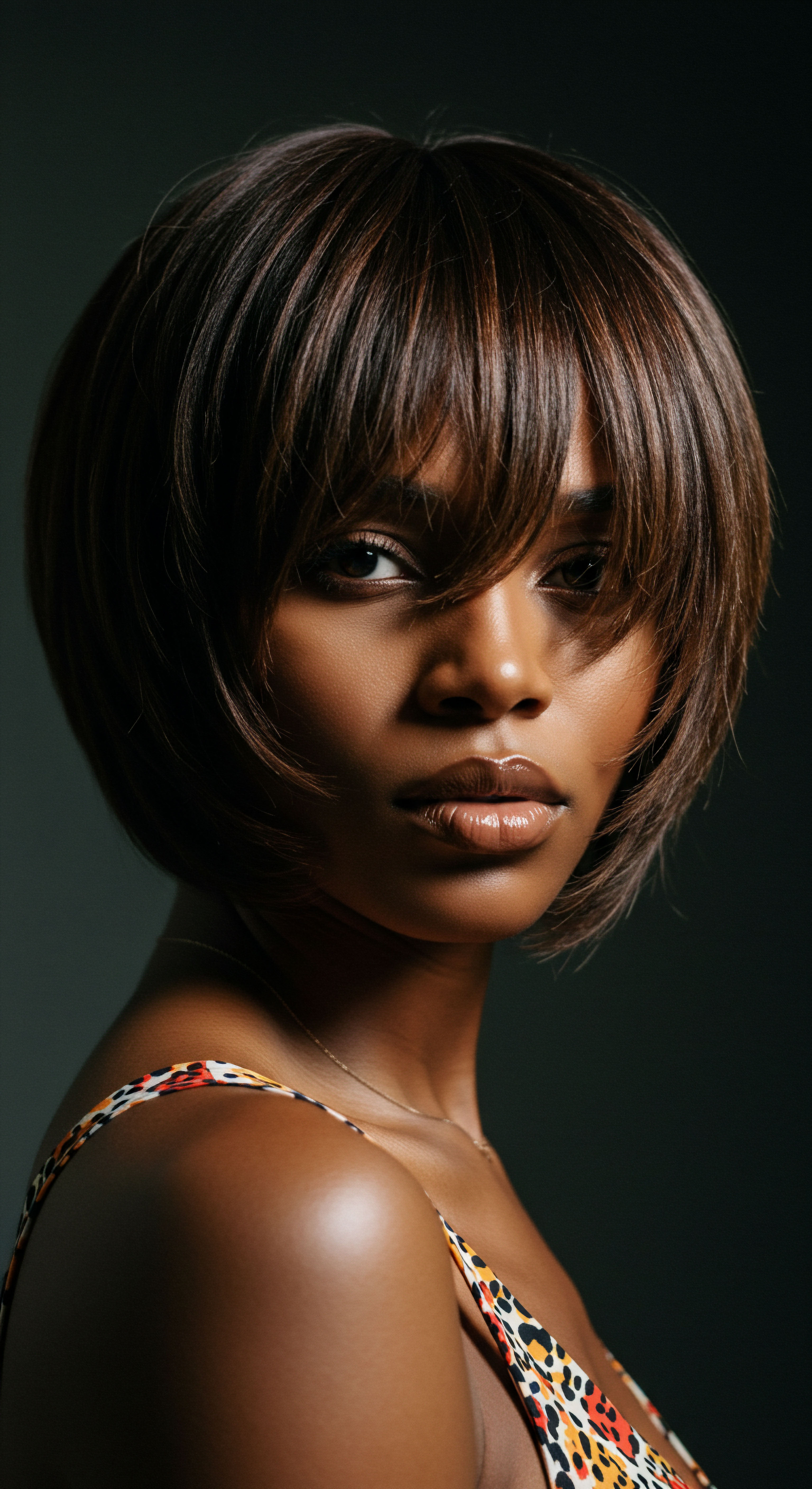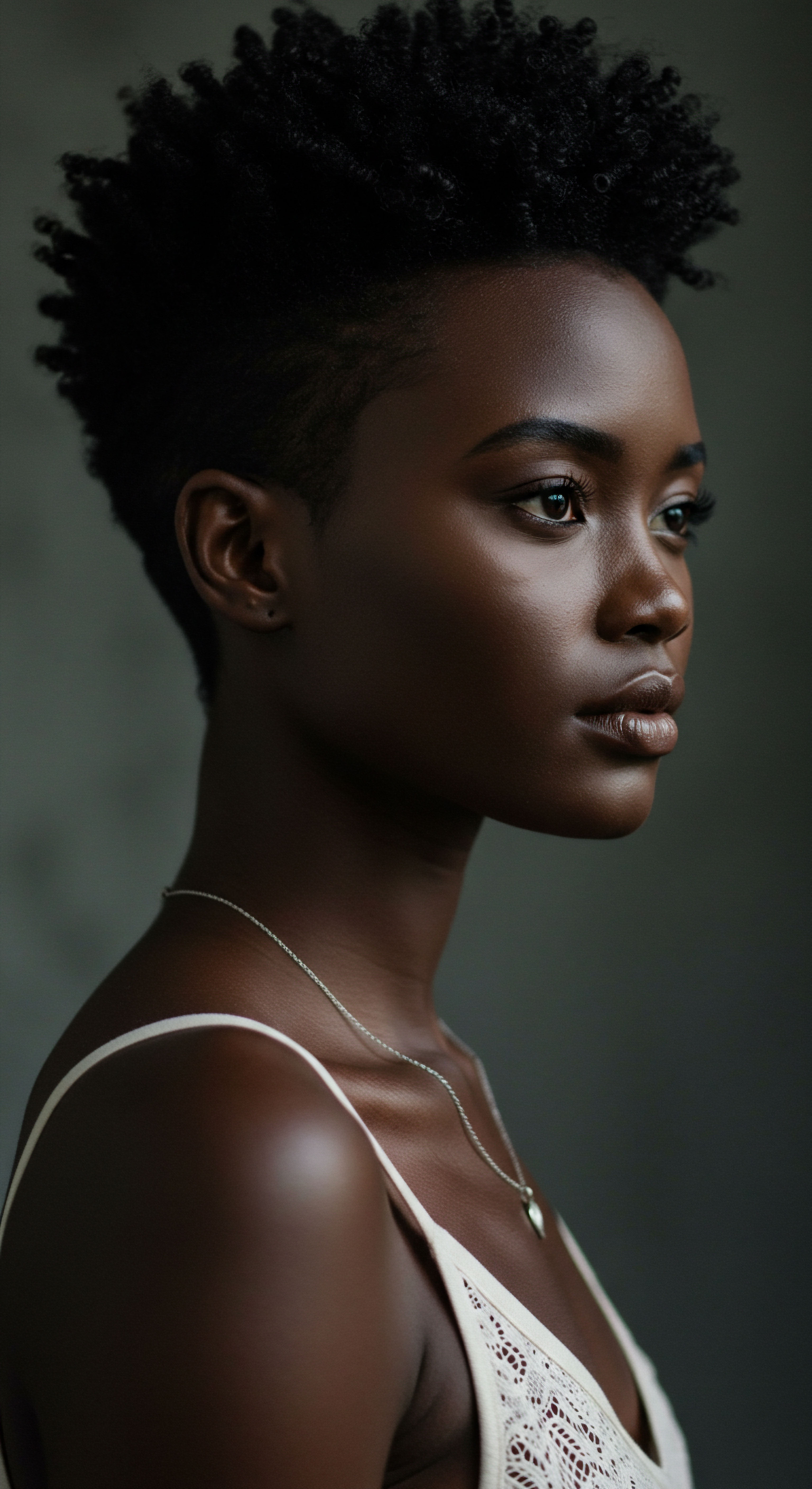
Roots
The way we care for our hair today, from the silk scarves we tie on before bed to the conditioning treatments we smooth onto our strands, holds whispers of practices stretching back through countless generations. It is a quiet truth that our modern routines are not born from a vacuum, but rather from a rich soil of human ingenuity, cultural expression, and the timeless need to protect what grows from our crowns. This quiet continuity, often unseen, reveals itself when we consider the enduring presence of head coverings across civilizations.
Across diverse societies and throughout recorded history, head coverings have served a multitude of purposes, extending far beyond mere adornment. They functioned as markers of social standing, age, and marital status. In many African cultures, specific headwrap styles conveyed a woman’s identity and community affiliation. Beyond social communication, these coverings offered practical protection from environmental elements.
Harsh sun, biting winds, and swirling dust found their match in layers of fabric, shielding delicate hair from damage. This protective aspect, so deeply rooted in the past, lays the very groundwork for contemporary hair care philosophies.

Ancient Hair Guardianship
From ancient Egypt to medieval Europe, people instinctively understood the vulnerability of hair. Egyptian artwork depicts nobility with elaborate head coverings, often adorned with precious materials, signifying wealth and status while also offering a degree of physical protection. In medieval Europe, women frequently wore their long hair braided and pinned close to the head, then covered it with linen veils or caps.
These coverings were changed regularly, acting as a buffer against dirt and absorbing oils, a clever system of cleanliness when frequent hair washing was not feasible. This historical practice of encasing hair for preservation directly influences our contemporary emphasis on minimizing external stressors.
The silent stories held within historical head coverings reveal an ancient understanding of hair’s fragility and the universal desire for its preservation.
The materials chosen for these early coverings also speak volumes about their protective function. Linen, a breathable and absorbent fiber, was a common choice in medieval times, helping to manage scalp oils and keep hair tidy. Later, silk became a favored material, particularly in Asian and Middle Eastern cultures, prized for its smooth texture that reduced friction and helped maintain hairstyles and luster. The preference for silk in these historical contexts directly foreshadows its celebrated status in modern hair care, where satin and silk bonnets are lauded for preventing tangles, frizz, and moisture loss during sleep.
Beyond the practical, a profound connection existed between hair, identity, and the act of covering. In some ancient traditions, hair was seen as a conduit for spiritual energy or a symbol of one’s inner state. Covering the head, therefore, could signify modesty, spiritual devotion, or a sacred boundary.
This reverence for hair, coupled with its physical safeguarding through coverings, established a foundational principle ❉ hair is something precious, deserving of thoughtful, consistent care. This deep-seated respect continues to inform the mindful routines we observe today, particularly within textured hair communities where hair holds significant cultural and personal meaning.
The wisdom of these early hair guardians, though expressed through different means, remains strikingly relevant. They understood that protection, thoughtful material selection, and reduced manipulation were cornerstones of healthy hair. These foundational insights, honed over centuries, gently guide the sophisticated hair care practices we now call our own.

Ritual
Stepping from the foundational wisdom of hair guardianship, we find ourselves amidst the rhythms of daily and nightly care, where historical head coverings have shaped our modern hair care routines in ways both subtle and overt. The practices once born of necessity, cultural observance, or even defiance, have transformed into cherished rituals aimed at preserving the health and vibrancy of textured hair. This section explores how the enduring presence of head coverings has sculpted our routines, from the tools we use to the very timing of our hair protection.

Nighttime Protection and Bonnet Wisdom
One of the most direct and pervasive influences of historical head coverings on modern hair care is the tradition of nighttime hair protection. The humble bonnet, a staple in textured hair care since at least the 1950s, serves as a direct descendant of earlier head coverings worn for sleep. These initial bonnets, often crafted from cotton or silk, aimed to completely cover the hair, shielding it from friction and moisture depletion during slumber. This practice recognized that movement against coarse pillowcases could lead to tangles, frizz, and breakage, especially for delicate textured strands.
- Satin Bonnets ❉ These are a direct evolution, designed to minimize friction against pillowcases, thus preventing breakage and preserving moisture.
- Silk Pillowcases ❉ An alternative to bonnets, these provide a smooth surface for hair to rest upon, reducing snagging and tangling.
- Loose Braids or Twists ❉ Often worn under bonnets, these styles further reduce manipulation and maintain definition overnight, a practice mirroring historical efforts to preserve intricate styles.
The contemporary use of satin or silk bonnets and pillowcases directly reflects this historical understanding. The smooth surface of these materials allows hair to glide freely, preventing the mechanical damage that cotton can inflict. This simple yet profound ritual, passed down through generations, ensures that curls remain defined, kinks stay supple, and moisture is retained, extending the life of styles and promoting overall hair well-being.

Preserving Style and Structure
Head coverings historically played a significant role in maintaining elaborate hairstyles for longer periods, reducing the need for frequent restyling. This concept carries into modern routines, particularly for textured hair, where styles like braids, twists, and locs are often protected to extend their wear. These “protective styles” are themselves deeply rooted in African traditions, serving not only aesthetic purposes but also safeguarding hair from environmental aggressors and excessive manipulation.
During the 1940s, for instance, head wraps and turbans became both fashionable and functional for Black women, serving as protective wear for factory workers. These coverings helped maintain hairstyles while meeting workplace safety requirements. This adaptation of traditional practices for contemporary needs demonstrates a continuity of purpose.
Modern textured hair care regimens frequently incorporate these styles, understanding that less daily handling means less breakage and more length retention. The covering, whether a headwrap for daily wear or a bonnet for sleep, becomes an essential tool in this strategy.
The strategic use of head coverings, from historical headwraps to modern bonnets, consistently aims to reduce friction and retain moisture, extending the life of hairstyles and promoting hair vitality.

Responding to the Covered Environment
While protective, historical head coverings also presented unique challenges that have subtly shaped modern hair care. For those who wore coverings for extended periods, such as for religious observance, concerns about scalp health sometimes arose. A study from Jakarta in 2020, involving women who wore hijabs, reported that 59.4% experienced scalp itching, 56.3% reported dandruff, and 6.3% reported hair loss. While the study found no statistically significant difference in scalp hydration or pH between hijab-wearing and non-hijab-wearing women, these reported complaints underscore the need for targeted care under covered conditions.
This real-world data point highlights the importance of adapting routines to the specific environment created by a covering. Modern hair care for covered hair often emphasizes:
- Thorough Cleansing ❉ Preventing sebum and product buildup, which can lead to scalp issues, becomes paramount. This may involve specific shampoos or co-washing methods.
- Adequate Drying ❉ Ensuring hair is fully dry before covering to prevent moisture accumulation and fungal growth, which can contribute to dandruff and itching.
- Breathable Materials ❉ Choosing coverings made from natural, breathable materials to allow for air circulation and reduce excessive humidity around the scalp.
- Targeted Scalp Care ❉ Incorporating scalp treatments, oils, or tonics to maintain a healthy scalp environment, addressing potential dryness or irritation that can occur when hair is consistently covered.
The interplay between historical practices and contemporary scientific understanding has given rise to sophisticated care strategies. The ancient recognition of hair’s vulnerability, amplified by the protective and sometimes challenging environment of head coverings, has directly contributed to our current understanding of how to maintain optimal hair health, particularly for the diverse textures that benefit most from mindful protection.

Relay
Moving beyond the daily rhythms of hair care, the deeper currents of history reveal how head coverings have influenced our understanding of hair’s very biology and the complex interplay of cultural forces shaping modern hair care science. This exploration extends beyond simple routines, delving into the nuanced connections between ancient practices, contemporary research, and the evolving perception of textured hair.

Historical Head Coverings and Hair Biology
The sustained practice of covering hair, particularly for prolonged periods, subtly interacted with hair’s natural physiology. While coverings offered protection from external aggressors, they also created a unique microclimate around the scalp. Early observations, even without the language of modern science, likely noted changes in hair texture, moisture levels, and scalp conditions that could be attributed to consistent covering.
For instance, the traditional use of silk and satin in many cultures for head coverings, including the Japanese “kazashi” or Middle Eastern hijabs, was not merely for adornment but also for preserving hair’s smoothness and preventing damage while sleeping or during daily activities. This inherent understanding of material science, long before laboratories existed, pointed to the role of reduced friction in maintaining hair integrity.
In modern scientific terms, covering hair, especially with smooth materials, minimizes mechanical abrasion against external surfaces and other hair strands. This reduction in friction helps to preserve the hair’s cuticle, the outermost protective layer of the hair shaft. When the cuticle remains smooth and intact, hair retains moisture more effectively, appears shinier, and is less prone to tangling and breakage. This fundamental biological principle, observed and responded to through centuries of covering practices, forms a bedrock of modern hair care, particularly for textured hair types which are more susceptible to dryness and mechanical damage due to their structural characteristics.
The subtle science of friction and moisture retention, once observed through generations of covered hair, now underpins many of our most effective textured hair care practices.
Consider the thermal regulation aspect as well. Hair acts as insulation, and head coverings modify the scalp’s thermal environment. While a nude scalp requires more sweat to achieve heat balance in a warm environment, any head covering can reduce the efficiency of evaporative heat loss.
This highlights a potential trade-off ❉ protection from external elements versus optimal scalp breathability. This historical tension between protection and potential occlusion has driven innovations in modern hair care products and techniques, focusing on lighter formulas, targeted scalp treatments, and materials that balance protection with aeration.

Cultural Adaptation and Hair Science
The forced covering of hair during periods of oppression, such as the Tignon Law in 18th-century Louisiana which compelled Black women to cover their hair, paradoxically spurred acts of creative resistance. Women decorated their wraps with jewels and feathers, transforming symbols of subjugation into statements of dignity and defiance. This spirit of adaptation and reclaiming identity through hair has continued to shape textured hair care.
The modern natural hair movement, for example, celebrates diverse textures and styles, rejecting Eurocentric beauty standards that historically devalued natural hair. Protective styles like braids, twists, and locs, which are often worn under coverings or as self-contained protective systems, are direct descendants of ancient African traditions that served both practical and symbolic purposes.
This historical context provides a deeper understanding of why modern textured hair care places such a strong emphasis on protective styling and nighttime routines. It is not merely a trend but a continuation of practices born from centuries of necessity and cultural resilience. The scientific backing for these practices is now clear ❉ minimizing manipulation, reducing environmental exposure, and preserving moisture are paramount for the health of highly textured hair.
A relevant research point comes from a 2023 cross-sectional study on the scalp microbiome of healthy women wearing hijab compared to those not wearing hijab. While the study found no statistically significant differences in scalp hydration or pH between the groups, it acknowledged that the use of hijab, especially for prolonged periods, “might occlude the scalp which results in accumulation of sebum and scalp. These can predispose the women to itch and dandruff.” The study also noted that “some of the women who do not dry their hair and use hijab directly might cause the hair flat and damaged.” This research, though not finding a direct negative physiological impact from covering itself, underscores the behavioral adaptations and specialized care that may be required when hair is consistently covered, such as ensuring hair is completely dry before covering and maintaining proper hygiene to mitigate potential issues like dandruff and itching. This highlights a modern scientific validation of concerns that may have been observed anecdotally for centuries, prompting the development of practices like thorough cleansing and targeted scalp treatments for covered hair.
| Historical Practice Wearing linen caps/veils |
| Underlying Principle Protection from dirt, absorption of oils |
| Modern Hair Care Routine Regular cleansing, dry shampoo use, protective styling |
| Historical Practice Using silk wraps for sleep |
| Underlying Principle Reducing friction, retaining moisture |
| Modern Hair Care Routine Satin/silk bonnets, pillowcases for nighttime protection |
| Historical Practice Braiding hair under coverings |
| Underlying Principle Minimizing manipulation, preserving style |
| Modern Hair Care Routine Protective styles (braids, twists, locs) for length retention |
| Historical Practice Headwraps for daily protection |
| Underlying Principle Shielding from environmental damage |
| Modern Hair Care Routine Daytime headwraps, scarves for UV protection |
The scientific community continues to explore the nuances of hair and scalp health under various conditions, including those influenced by head coverings. This continuous inquiry, coupled with the rich cultural heritage of hair care practices, provides a compelling testament to how deeply historical traditions continue to shape our modern understanding and approach to caring for textured hair. The lessons from the past, sometimes subtle and sometimes overt, are woven into the very fabric of our contemporary hair wellness philosophies.

Reflection
As we conclude this exploration, it becomes clear that the threads connecting historical head coverings to modern hair care routines are more than mere coincidences; they represent a deep, enduring dialogue between past wisdom and present practices. The simple act of covering one’s head, whether for modesty, protection, or status, initiated a series of adaptations in hair care that continue to echo in our daily lives. From the widespread adoption of satin bonnets to the resurgence of protective styles, we see a continuous line of care, born from a recognition of hair’s inherent delicacy and its profound cultural weight.
The story of head coverings and hair care is a testament to human adaptability, creativity, and the persistent desire to honor and preserve our crowning glories. It reminds us that beauty rituals are never static; they are living legacies, constantly shaped by history, culture, and our ever-deepening understanding of ourselves.

References
- JD Institute of Fashion Technology. (2021). HEADWRAPS ❉ HISTORY AND EVOLUTION.
- Obé Headwear. (2024). Significance of headwraps | Hair care.
- The Wrap Life. (2022). A Beautiful Record of How Modern Headwraps.
- Amazingy Magazine. (2024). A History of Haircare.
- LuxCare. The Evolution of Headscarves ❉ from ancient Egypt to the red carpet.
- Annie International, Inc. (2023). The Origin Story Of The Bonnet.
- Hairfinder. Books about the history of hair | Historical hairstyles.
- Root Awakening Hair Spa. (2024). Textured Hair Care Through the Decades ❉ The 1940s – War, Work, and Waves.
- Hype Hair. (2023). Unveiling the History of the Hair Bonnet for Black Women.
- The Ultimate Guide to Hair Bonnets ❉ Everything You Need to Know. (2023).
- B.O.M.M. (2023). Bonnets ❉ A Cultural Staple in Black Communities.
- Goodreads. Popular History Cosmetics Books.
- Ashland Community and Technical College – KCTCS. (2024). History of Cosmetology.
- Flora & Curl. The History of Black Hairstyles.
- Leone Culture. (2023). Exploring the Significance Of Headwraps In African Fashion And Traditions.
- Afro Street. (2025). The Cultural Significance of Headwraps & How to Wear Them ❉ Embracing Heritage and Style.
- Cee Cee’s Closet NYC. (2021). The History of Bonnets.
- Jewish Head Coverings.
- Afriklens. (2024). African Hairstyles ❉ Cultural Significance and Legacy.
- Historical Perspectives on Hair Care and Common Styling Practices in Black Women. (2025).
- Herbs & Oils Haircare Essentials. The History & Power of Protective Styles.
- Sartorial Magazine. (2025). Braids, Locs, and Beyond ❉ The Beauty and History of Protective Styles.
- Hair Care Practices from the Diaspora ❉ A Look at Africa, America, and Europe. (2025).
- Synnott, Anthony. (1987). Shame and Glory ❉ A Sociology of Hair. BRIT. J. SOC. 48, 381, 390.
- Wikipedia. Protective hairstyle.
- Reddit. (2025). Is there a book about historical beauty practices? ❉ r/suggestmeabook.
- The Makeup Museum. (2014). Book review ❉ Beauty and Cosmetics, 1550-1950.
- Katherine Haircare. (2022). Historical Hair Care Grew My Hair to Hip Length! Here’s How.
- colleen. (2020). The History of Textured Hair.
- Evaluation of Scalp Hydration and pH Values in Hijab-Wearing and Non-H | IJWH. (2023).
- SnappyDragon Studios. (2024). Medieval Hair Washing Myths Busted.
- STUDY CASE WOMEN HAIR WITH HIJAB – Repository UHAMKA.
- JD Institute. (2024). Cultural Inspirations in Hair Styling ❉ A Global Perspective.
- BarberSets. (2023). Haircare and Cultural Expression ❉ A Look at Global Styles.
- YouTube. (2023). Ultimate Historical Hair Care Guide | Straight, Curly & Kinky.
- Ruwaa Life. (2024). Tresses Through Time ❉ A Journey Through the History of Hair Care.
- Open Anthropology. (2018). Hair Everywhere ❉ Anthropological Notes on the Long and Short of It.
- bioRxiv. (2023). Human scalp hair as a thermoregulatory adaptation.
- Reddit. (2022). Medieval hair care approach as emergency strategy ❉ r/TwoXPreppers.
- Scholarly Publications Leiden University. (2024). Clinical aspects of scalp cooling in chemotherapy induced alopecia.
- Sew Historically. (2015). Night-Time Hair Routine – Victorian And Edwardian Hair Care.
- Theology in the raw. (2024). The Cultural Context for the Hair Length/Style vs. Head-coverings Debate in 1 Cor 11 ❉ The Meaning of Kephalē part 12.
- Esme Luxury. (2024). Silk Hair Wraps in Different Cultures ❉ A Global Perspective.
- ResearchGate. (2020). Religious Identity, Challenge, and Clothing ❉ Women’s Head and Hair Covering in Islam and Judaism.
- PubMed Central. (2023). Scalp microbiome of healthy women wearing hijab compared to those not wearing hijab ❉ a cross-sectional study.